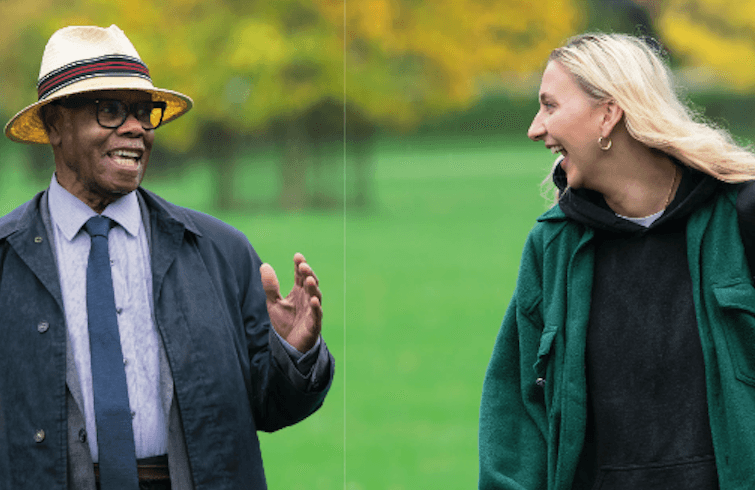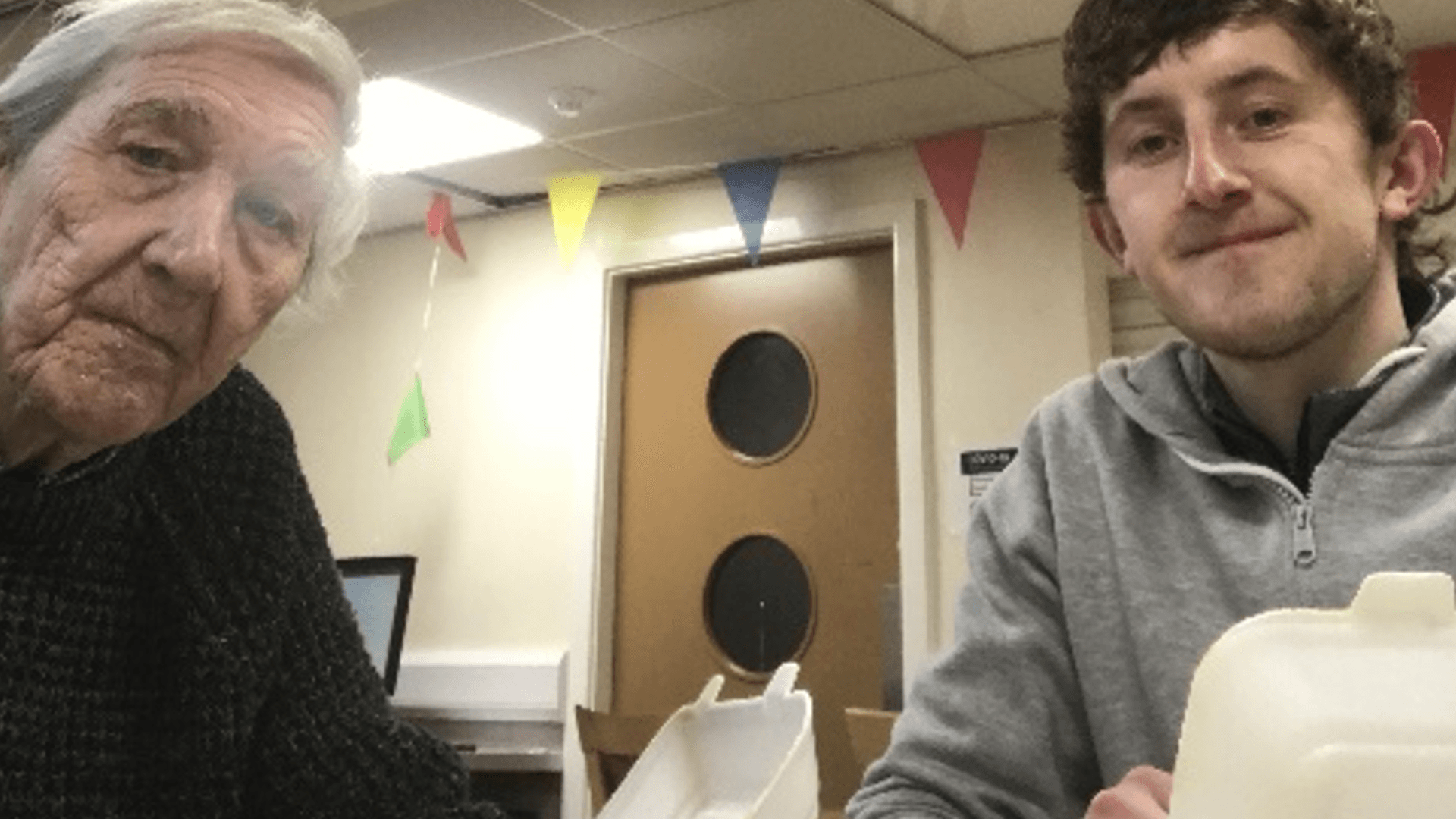
A year on: How the pandemic has shown the danger of isolation, and the opportunity of connection
Posted by The Cares Family on 10th March 2021
Please note: this post is 57 months old and The Cares Family is no longer operational. This post is shared for information only
By Alex Smith
A year ago, I sat in a cafe in Tottenham, on the phone to colleagues as we made the hardest decision about The Cares Family’s intergenerational communities we’d ever made. The emergency call had dislodged a routine meeting to discuss our new 3G project that would build connection between older people, new parents and their young children. Now, a virus carried by everyone and harming older people in particular was spreading at pace.
Two days earlier I’d sat with brilliant organisations seeking to bring neighbours together everywhere. My voice had cracked as I asked the inevitable question: 'We’ve talked about the slow-burn of the loneliness epidemic for a decade. Now we’re facing an urgent health crisis and older and younger people will have to stay apart. Does this render our work obsolete?'
There was a heavy pause. I ran through the options in my mind. As people shielded from the virus, could we mobilise our communities to deliver food and medicine to wherever it was needed? Would we re-purpose our organisation to support the NHS? Could we build a tool to help people everywhere to build connection on the phone? Or, as fundraising events were cancelled, would we try to make a difference as long as possible, really just delaying the inevitable closure of another charity that showed promise before disappearing forever?
Then the answer came, echoing around the room. 'No. This makes your work more important than ever. If people are stuck in their homes, loneliness will deepen. Everyone will feel the effects of isolation. This will show how much people need each other.' It was all I needed to hear.
Back in Tottenham, we made the decision. The Cares Family would suspend face-to-face programmes bringing the generations together. Truth be told, we had no choice. We’d started hearing from partners in local hospitals that the situation was worse than was being reported. Health workers were already overwhelmed. This was catastrophic.
But because we’d also heard from older and younger neighbours that there was as much fear of social isolation as there was of the virus itself, we made another choice that day too. We would do everything we could to help people find connection in deeply disconnecting times. We would communicate with thousands of people in our communities as quickly as we could to let people know that The Cares Family was exactly that – a family. Meanwhile, our teams worked with energy and creativity to re-invent our programmes so that they could keep people connected even from afar. We didn't expect a pandemic, but this is what we came here to do.
The year since has been extraordinary. Through those re-invented programmes, 6,832 older and younger people have offered one another solace and solidarity, patience and perspective, fun and friendship. 903 friends have shared 859 social clubs – not just on Zoom but through beautiful group phone calls and Cosy Clubs for those still building social confidence.
‘There are activities I’d never have done in my life.’
— Alex Smith (@alexsmith1982) December 26, 2021
This is the loveliest film about @TheCaresFamily – a group of friends, a community, a family in so much more than name:pic.twitter.com/xlKIMhp5sW
Younger people have patiently helped older neighbours to cross the digital divide. Another 592 intergenerational friends have shared 6,547 chats one-to-one – on the phone, on doorsteps and in parks when it was safe to do so. And 102,430 #AloneTogether activity packs have been shared with 19,000 older and younger neighbours as well as nearly 1,000 partners in our communities – and far beyond.
Zoom In Your Room support has been a crucial way to troubleshoot any technical problems the neighbours are experiencing.
— South London Cares (@SouthLDNCares) July 24, 2020
In this session, Fadha learned what the problem was with her microphone and made sure to write it down so that she can fix it herself should it happen again. pic.twitter.com/pX5WU7qNbE
All told, neighbours have shared thousands of hours during the course of the pandemic. Meanwhile, our teams have made 20,000 phone calls – inviting people to join activities, supporting people with 3,958 practical interventions like referrals to local health and social services, and more recently sharing information on how neighbours can get their vaccinations. Those interactions have had an extraordinary impact. The feedback we hear most often is that these relationships are ‘a lifeline’.
The magic of intergenerational connection, of course, has always been that the value goes both ways. So it’s not just older people who have benefitted. Younger people – many working from home or trapped in university halls, some experiencing this depth of isolation for the first time – have benefitted too. As Emilia said of Sid, who’s 92: “I’ve gained a friend, role model, life coach and I’m given all the free advice a confused 25 year old could need.” When Aimee’s wedding was cancelled, it was 81 year-old Val who cheered her up.

Of course, we recognise that alongside the joy of human connection, pain and trauma have also proliferated across society. Our communities have lost many friends over the past year, and we’ve taken time to reflect and to grieve collectively. We’ve seen many of the world’s injustices laid bare in the uneven distribution of loss, of access and of justice. We have accelerated our efforts to do what we can to help end those injustices, developing deep anti-racism work, raising our communities’ voice on the digital divide, and challenging stereotypes about older and younger people alike, most recently through National Intergenerational Week.
We’ve also launched our new Multiplier programme to help people build bridges in their own communities in their own ways. Over the next five years, 50 Multipliers will come together to learn from one another, to share skills, and to lift up stories about the power of relationships across different experiences that, in times of challenge and change, may otherwise polarise. That’s the power of the ripple effect. Together, our vision is to build a more connected age.
Disconnection is everywhere, but so are solutions that will help thwart it.
— The Cares Family (@TheCaresFamily) February 8, 2021
We’re proud to introduce our Multipliers who are each building connection in their own communities in their own ways.
Find out more about our first 11 inspiring Multipliers:https://t.co/HbZUgWM2SH pic.twitter.com/VZK9cRmfSL
We know that this crisis is not over. Far from it: the long tail of consequence of the pandemic will whip for a generation, particularly as power and powerlessness continue to concentrate in pockets, perpetuated by the uneven distribution of access and relationships. In that context, The Cares Family's work is just beginning.
But what we have seen again over the past year is that isolation is a gateway to so many social ills. After this pandemic, there is no excuse not to make a collective national effort to overcome our other pandemics – of loneliness, of disconnection, of social, digital, generational and attitudinal divides. As we look ahead, we're optimistic about what we can achieve with partners all over the country to progress that mission – finding a new blend of face-to-face and remote interactions; supporting others to bring people together everywhere; and building a ripple effect of connection all across the country.
As for the 3G project we were due to plan that day in Tottenham a year ago, this week we published its evaluation report. It shows the impact of intergenerational connection in lifting up empathy in times of change. I’ll leave the final word to one of the neighbours who felt that benefit:
“You understand what different generations feel about life: we can all learn from each other to understand each other’s points of view.”


